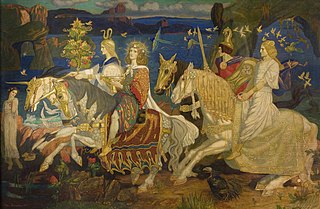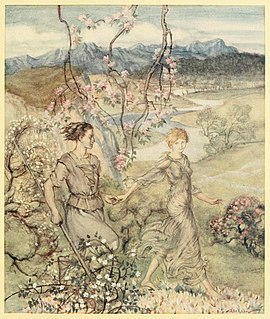Related Research Articles

Irish mythology is the body of myths native to the island of Ireland. It was originally passed down orally in the prehistoric era, being part of ancient Celtic religion. Many myths were later written down in the early medieval era by Christian scribes, who modified and Christianized them to some extent. This body of myths is the largest and best preserved of all the branches of Celtic mythology. The tales and themes continued to be developed over time, and the oral tradition continued in Irish folklore alongside the written tradition, but the main themes and characters remained largely consistent.

Manannán or Manann, also known as Manannán mac Lir, is a warrior and king of the Otherworld in Irish mythology who is associated with the sea and often interpreted as a sea god, usually as a member of the Tuatha Dé Danann.
Annwn, Annwfn, or Annwfyn is the Otherworld in Welsh mythology. Ruled by Arawn, it was essentially a world of delights and eternal youth where disease was absent and food was ever-abundant. It became identified with the Christian afterlife in paradise.
Fand or Fann is an otherworldly woman in Irish mythology. The two forms of her name are not phonetic variants, but two different words of different meaning and the history of her name is debated.
Lí Ban may refer to an otherworldly female figure in Irish mythology.

The Ulster Cycle, formerly known as the Red Branch Cycle, is a body of medieval Irish heroic legends and sagas of the Ulaid. It is set far in the past, in what is now eastern Ulster and northern Leinster, particularly counties Armagh, Down and Louth. It focuses on the mythical Ulster king Conchobar mac Nessa and his court at Emain Macha, the hero Cú Chulainn, and their conflict with the Connachta and queen Medb. The longest and most important tale is the epic Táin Bó Cúailnge. The Ulster Cycle is one of the four 'cycles' of Irish mythology and legend, along with the Mythological Cycle, the Fianna Cycle and the Kings' Cycle.
Lebor na hUidre or the Book of the Dun Cow is an Irish vellum manuscript dating to the 12th century. It is the oldest extant manuscript in Irish. It is held in the Royal Irish Academy and is badly damaged: only 67 leaves remain and many of the texts are incomplete. It is named after an anachronistic legend that it was made from the hide of a dun cow by Saint Ciarán of Clonmacnoise.
Mongfind —meaning "fair hair" or "white hair"—is a figure from Irish legend. She is said to have been the wife, of apparent Munster origins, of the legendary High King Eochaid Mugmedón and mother of his eldest three sons, Brión, Ailill and Fiachrae, ancestors of the historical Connachta. She was Eochaid's first wife; his second wife, Cairenn, gave birth to Niall of the Nine Hostages. Several tales depict Mongfind as an adversary of Niall. Mongfind is also said to have been the sister of Crimthann mac Fidaig, King of Munster and the next High King of Ireland, whom she is said to have killed with poison in a bid to make her son king. She drank the poisoned drink to convince Crimthann, and died soon after at Samhain.
The Voyage of Bran is a medieval seventh- or eighth-century Irish language narrative.

In Celtic mythology, the Otherworld is the realm of the deities and possibly also the dead. In Gaelic and Brittonic myth it is usually a supernatural realm of everlasting youth, beauty, health, abundance and joy. It is described either as a parallel world that exists alongside our own, or as a heavenly land beyond the sea or under the earth. The Otherworld is usually elusive, but various mythical heroes visit it either through chance or after being invited by one of its residents. They often reach it by entering ancient burial mounds or caves, or by going under water or across the western sea. Sometimes, they suddenly find themselves in the Otherworld with the appearance of a magic mist, supernatural beings or unusual animals. An otherworldly woman may invite the hero into the Otherworld by offering an apple or a silver apple branch, or a ball of thread to follow as it unwinds.

Láeg, or Lóeg, son of Riangabar, is the charioteer and constant companion of the hero Cú Chulainn in the Ulster Cycle of Irish mythology. His horses are Liath Macha and Dub Sainglend.
In Irish mythology Tír na nÓg or Tír na hÓige is one of the names for the Celtic Otherworld, or perhaps for a part of it. Tír na nÓg is best known from the tale of Oisín and Niamh.
The golden apple is an element that appears in various national and ethnic folk legends or fairy tales. Recurring themes depict a hero retrieving the golden apples hidden or stolen by a monstrous antagonist. Gold apples also appear on the Silver Branch of the Otherworld in Irish mythology.

An immram is a class of Old Irish tales concerning a hero's sea journey to the Otherworld. Written in the Christian era and essentially Christian in aspect, they preserve elements of Irish mythology.
The Wasteland is a Celtic motif that ties the barrenness of a land with a curse that must be lifted by a hero. It occurs in Irish mythology and French Grail romances, and hints of it may be found in the Welsh Mabinogion.
Aided Óenfhir Aífe is a story from the Ulster Cycle of Irish mythology.

Serglige Con Culainn, also known as Oenét Emire is a narrative from the Ulster Cycle of Irish mythology. It tells of a curse that fell upon the warrior Cú Chulainn as a result of his attacking otherworldly women, and his eventual recovery by reluctantly agreeing to give military aid to those he had wronged. His developing relationship with one of the Otherworldly women, Fand, occasions his wife Emer's "only jealousy."
Mongán mac Fíachnai was an Irish prince of the Cruthin, a son of Fíachnae mac Báetáin. Little is certainly known of Mongán's life as only his death is recorded in the Irish annals. He appears as a character in the Cycles of the Kings where he is said to have been the son of Manannán mac Lir and perhaps a reincarnation of the legendary hero Finn mac Cumaill of the Fenian Cycle.

The Silver Branch or Silver Bough is a symbol found in Irish mythology and literature.

Echtra Condla, is an Old Irish echtra tale known in two variants from eight manuscripts, the earliest of which has been dated to the 12th C. - the tale may have been written down first as early as the 8th C. The two variants do not diverge sharply from one another, so that a single summary suffices for both.
References
Sources
- MacKillop, James (1998), Dictionary of Celtic Mythology, Oxford, ISBN 978-0-19-860967-4
- Dumville, David N. (1976), "Echtrae and Immram: Some Problems of Definition", Ériu, Royal Irish Academy, 27: 73–94, JSTOR 30007669
- Duignan, Leonie (2010), The Echtrae as an Early Irish Literatary Genre (thesis), NUI Maynooth